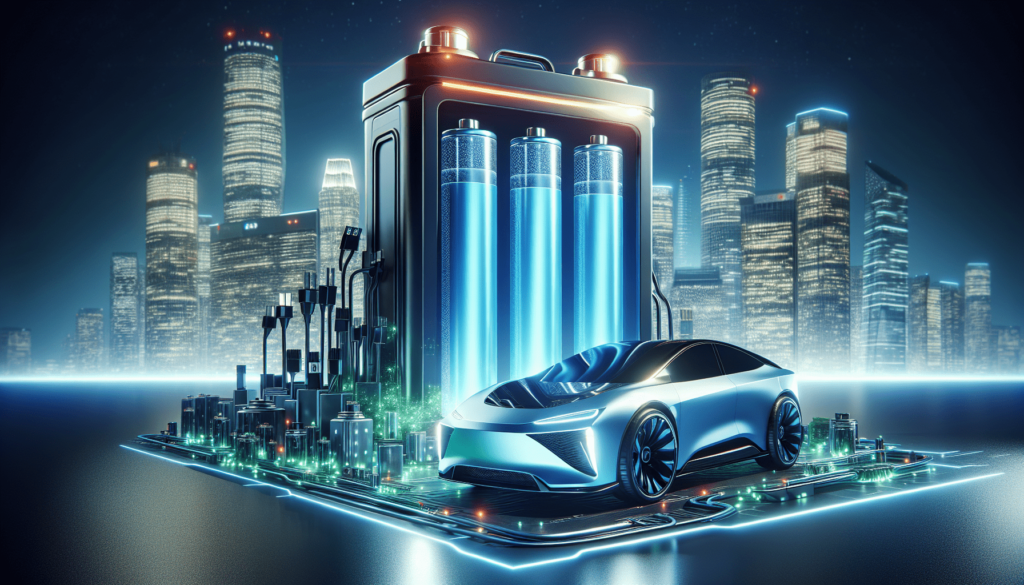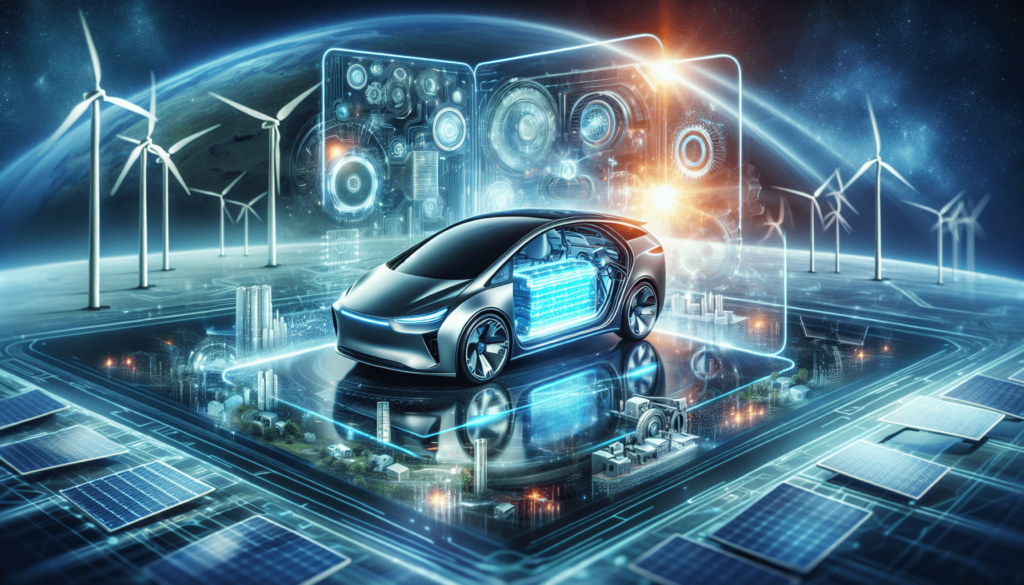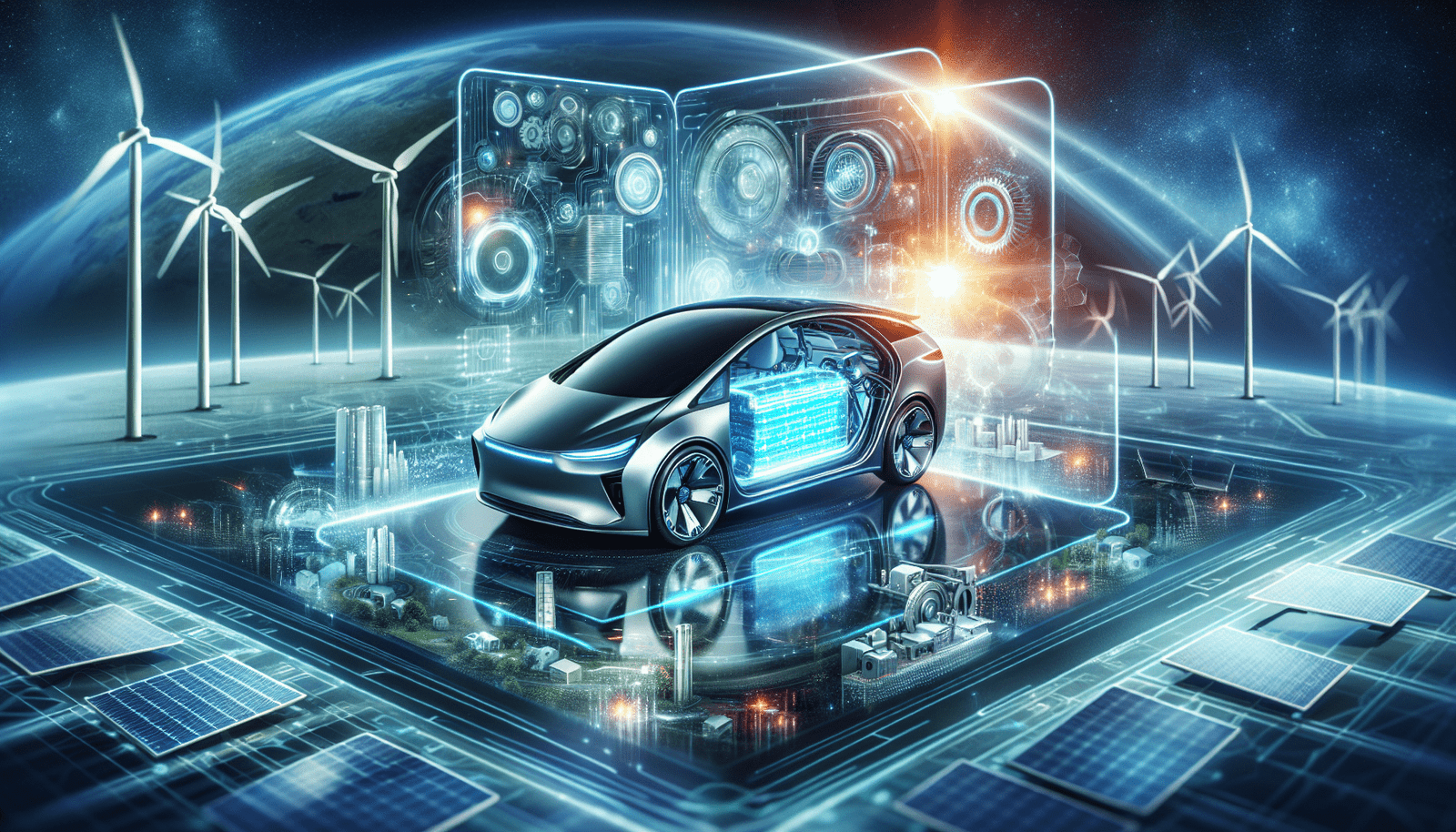Imagine a world where electric vehicles can travel longer distances on a single charge, can charge faster, and are lighter and safer. This futuristic vision could soon become a reality with the potential rise of solid-state batteries in electric vehicles. Solid-state batteries offer immense promise in revolutionizing the capabilities of electric vehicles, with their ability to store more energy, provide faster charging, and improve overall performance. As researchers continue to explore the possibilities, the prospects for solid-state batteries in electric vehicles seem to be teeming with potential.

Introduction to solid-state batteries
Solid-state batteries are a promising technology that is gaining attention in the world of electric vehicles (EVs) due to their potential to overcome the limitations of traditional lithium-ion batteries. As the name suggests, solid-state batteries use solid electrodes and a solid electrolyte instead of the liquid or gel electrolytes used in conventional batteries. This fundamental difference in composition and structure offers several advantages that could revolutionize the EV industry.
Definition of solid-state batteries
Solid-state batteries are a type of rechargeable battery that employs solid electrodes and a solid electrolyte. The electrodes are typically made of lithium, while the solid electrolyte can be composed of various materials such as ceramics, polymers, or nanocomposites. Unlike traditional lithium-ion batteries, which use liquid electrolytes, solid-state batteries eliminate the risk of leakage, resulting in improved safety and stability.
Composition and structure
Solid-state batteries consist of three main components: the positive electrode (cathode), the negative electrode (anode), and the solid electrolyte. The positive electrode is typically made of lithium cobalt oxide, while the negative electrode is usually made of lithium metal or graphite. The solid electrolyte, which separates the electrodes and facilitates the movement of lithium ions, can be made of materials such as lithium phosphorous oxynitride or sulfide-based compounds.
Advantages over traditional lithium-ion batteries
Solid-state batteries offer several advantages over traditional lithium-ion batteries, making them an attractive option for electric vehicles:
-
Improved safety: The use of a solid electrolyte eliminates the flammable liquid electrolytes found in conventional batteries, reducing the risk of fire and explosion. This makes solid-state batteries safer, especially in high-temperature environments or during accidents.
-
Higher energy density: Solid-state batteries have the potential to achieve higher energy densities, meaning they can store more energy in the same volume. This translates to longer driving ranges for electric vehicles without the need for larger and heavier battery packs.
-
Faster charging times: Solid-state batteries have the potential to significantly reduce charging times compared to traditional lithium-ion batteries. This is due to their ability to withstand higher charging currents without the risk of degradation or overheating.
-
Longer lifespan: Solid-state batteries have the potential to offer a longer cycle life compared to traditional lithium-ion batteries. This means that they can endure a higher number of charge-discharge cycles before experiencing significant capacity loss, leading to prolonged battery life and reduced maintenance costs for EV owners.
-
Reduced environmental impact: Solid-state batteries have the potential to be more environmentally friendly compared to traditional lithium-ion batteries. They can be manufactured using less toxic or more sustainable materials, leading to a reduced carbon footprint throughout the battery’s life cycle.
Current challenges and limitations
While solid-state batteries offer numerous advantages, there are still several challenges and limitations that need to be overcome before they can be widely adopted in electric vehicles.
Cost and manufacturing challenges
One of the main challenges for solid-state batteries is their high manufacturing cost. The production process involves complex and precise manufacturing techniques, which can be expensive. Additionally, the current lack of large-scale production infrastructure for solid-state batteries further increases the cost.
Limited energy density
Although solid-state batteries have the potential for higher energy density, current prototypes still fall short of the energy density of traditional lithium-ion batteries. This limitation hinders their ability to provide long driving ranges and may require larger battery packs to compensate.
Safety concerns
While solid-state batteries are generally considered safer than traditional lithium-ion batteries, there are still safety concerns associated with their use. Issues such as dendrite formation, which can lead to short-circuits and reduce battery life, need to be addressed for widespread adoption.
Temperature sensitivity
Solid-state batteries are sensitive to temperature variations, especially at extreme temperatures. This can affect their performance and lead to reduced efficiency or even failure. Ensuring reliable operation in a wide range of temperatures is crucial for their successful integration into electric vehicles.
Integration with existing infrastructure
Solid-state batteries have different physical and chemical properties compared to traditional lithium-ion batteries, which poses challenges for their integration into existing EV designs. This includes adapting battery management systems, charging infrastructure, and overall vehicle architecture to accommodate their specific requirements.
Advantages of solid-state batteries for electric vehicles
Despite the challenges and limitations, solid-state batteries hold significant promise for electric vehicles and offer several advantages that can transform the EV industry.
Improved energy density
Solid-state batteries have the potential to achieve higher energy densities compared to traditional lithium-ion batteries. This means that electric vehicles powered by solid-state batteries can have longer driving ranges without the need for larger and heavier battery packs, providing a more practical and convenient solution for EV owners.
Faster charging times
One of the most significant advantages of solid-state batteries is their ability to withstand high charging currents, enabling faster charging times. This can significantly reduce the amount of time spent waiting for an EV to charge, making electric vehicles more practical for everyday use and promoting their widespread adoption.
Enhanced safety features
Solid-state batteries offer enhanced safety features compared to traditional lithium-ion batteries. The absence of flammable liquid electrolytes eliminates the risk of leakage or thermal runaway, reducing the chances of fire or explosion. This not only enhances the safety of electric vehicles but also alleviates concerns for consumers and regulators.
Longer lifespan
Solid-state batteries have the potential to offer a longer lifespan compared to traditional lithium-ion batteries. With a higher number of charge-discharge cycles before significant capacity loss, electric vehicle owners can enjoy extended battery life and reduce the need for frequent battery replacements, resulting in cost savings and improved customer satisfaction.
Reduced environmental impact
The use of solid-state batteries in electric vehicles can contribute to a reduced environmental impact. Solid-state batteries can be manufactured using less toxic or more sustainable materials, reducing the reliance on scarce resources like cobalt. Additionally, their longer lifespan and improved energy density can lead to a reduced carbon footprint throughout the battery’s life cycle.

Progress in solid-state battery technology
Significant progress has been made in solid-state battery technology in recent years, bringing this promising technology closer to commercialization.
Advancements in materials
Researchers and manufacturers are actively exploring various materials for solid-state batteries to improve their performance. This includes the development of new solid electrolytes with higher ionic conductivities, stable lithium metal anodes, and advanced cathode materials. These advancements are crucial for achieving higher energy densities, longer lifespans, and improved safety features.
Innovative production techniques
New production techniques are being developed to overcome the manufacturing challenges of solid-state batteries. Techniques such as roll-to-roll manufacturing, additive manufacturing, and sputtering deposition are being explored to facilitate large-scale production and reduce costs. These innovations are essential for making solid-state batteries commercially viable for the electric vehicle market.
Increased investment and research
Government agencies, private companies, and research institutions have made substantial investments in solid-state battery research and development. This includes funding for research projects, establishing research centers, and fostering collaborations between industry and academia. The increased investment in solid-state battery technology is driving advancements and accelerating the path to commercialization.
Partnerships and collaborations
Collaborations between battery manufacturers, automakers, and research institutions have emerged to accelerate the development and commercialization of solid-state batteries. These partnerships leverage the expertise and resources of different stakeholders to address the technical challenges and bring solid-state batteries to market. Collaboration is essential for overcoming the complex and multidisciplinary nature of solid-state battery technology.
Implications for electric vehicle industry
The adoption of solid-state batteries in electric vehicles can have significant implications for the EV industry and shape the future of transportation.
Extended driving range
By offering higher energy densities, solid-state batteries can enable electric vehicles to achieve longer driving ranges without compromising on battery size or weight. This addresses one of the main barriers to EV adoption by alleviating the range anxiety often associated with electric vehicles. Drivers can travel longer distances between charges, making electric vehicles more practical for everyday use and increasing their appeal to a wider range of customers.
Reduced charging times
Solid-state batteries’ ability to withstand high charging currents enables faster charging times compared to traditional lithium-ion batteries. This means that EV owners can charge their vehicles in significantly less time, making electric vehicle charging more convenient and comparable to refueling a conventional car. Reduced charging times can help alleviate concerns about long charging stops and further democratize the adoption of electric vehicles.
Improved performance
Solid-state batteries can improve the overall performance of electric vehicles. The higher energy densities and faster charging times translate to improved acceleration and enhanced responsiveness. Additionally, the longer lifespan of solid-state batteries reduces the need for frequent battery replacements, saving costs and increasing the overall reliability of electric vehicles.
Increased market competitiveness
The commercialization of solid-state batteries can enhance the competitiveness of electric vehicles in the automotive market. With extended driving ranges, reduced charging times, and improved performance, electric vehicles powered by solid-state batteries can rival the convenience and performance of internal combustion engine vehicles. This can accelerate the transition from fossil fuel-powered vehicles to electric vehicles, leading to a more sustainable and environmentally friendly transportation system.
Transition towards sustainable transportation
The adoption of solid-state batteries in electric vehicles aligns with the global shift towards sustainable transportation. Electric vehicles already offer numerous environmental benefits, such as zero tailpipe emissions and reduced dependence on fossil fuels. By further improving energy density, charging times, and overall performance, solid-state batteries can accelerate the transition towards a more sustainable transportation system and contribute to the reduction of greenhouse gas emissions.
Market adoption and commercialization
The market adoption and commercialization of solid-state batteries in electric vehicles are still in the early stages, but progress is being made.
Current market landscape
While several companies worldwide are actively researching and developing solid-state batteries, there are currently no commercially available electric vehicles with solid-state batteries. However, major automakers, including Toyota, BMW, and Volkswagen, have announced plans to introduce electric vehicles with solid-state batteries in the next decade.
Major players in solid-state battery research
Many major players in the battery industry, as well as startups and research institutions, are investing in solid-state battery research and development. Companies such as Samsung, Panasonic, and Dyson, along with research institutions like the Massachusetts Institute of Technology (MIT) and Lawrence Berkeley National Laboratory, are actively working on advancing solid-state battery technology.
Timeline for commercialization
While the exact timeline for commercialization is uncertain, industry experts predict that the first electric vehicles with solid-state batteries could enter the market in the next five to ten years. The commercialization timeline depends on overcoming the technical challenges, scaling up production, and ensuring the long-term reliability and safety of solid-state batteries.
Potential impact on electric vehicle market
The introduction of electric vehicles with solid-state batteries could have a significant impact on the electric vehicle market. These vehicles would offer improved driving ranges, reduced charging times, and enhanced overall performance, making them even more attractive to consumers. If solid-state batteries can live up to their promise, they have the potential to accelerate the adoption of electric vehicles and drive further market growth.
Government support and regulations
Government support and regulations play a crucial role in the development and commercialization of solid-state battery technology.
Incentives for solid-state battery development
Government incentives, such as grants, tax credits, and research funding, can spur investment in solid-state battery research and development. These incentives encourage companies and research institutions to explore new materials, production techniques, and manufacturing processes, accelerating the development and commercialization of solid-state batteries.
Regulatory frameworks and standards
Regulatory frameworks and standards need to be developed to ensure the safety, reliability, and interoperability of solid-state batteries. Governments and regulatory bodies play a vital role in establishing guidelines and standards for solid-state battery manufacturing, testing, and usage. This ensures uniformity and promotes consumer confidence in solid-state battery technology.
Government initiatives and funding
Government initiatives and funding programs are actively supporting solid-state battery research and development. For example, the U.S. Department of Energy’s Advanced Research Projects Agency-Energy (ARPA-E) has invested in solid-state battery projects to accelerate their commercialization. Additionally, governments worldwide are investing in building infrastructure for battery manufacturing and supporting research collaborations to advance solid-state battery technology.
Integration challenges and infrastructure requirements
The integration of solid-state batteries into electric vehicles presents several challenges and infrastructure requirements.
Compatibility with existing electric vehicle designs
Electric vehicles with solid-state batteries require compatibility with existing electric vehicle designs. This includes adapting battery management systems, charging protocols, and overall vehicle architecture to accommodate the unique characteristics of solid-state batteries. Manufacturers and researchers need to collaborate to ensure a smooth integration of solid-state batteries into electric vehicles without compromising performance, safety, or reliability.
Need for charging infrastructure upgrades
Faster charging times and increased energy densities of solid-state batteries require upgrades to existing charging infrastructure. Higher charging currents must be supported, and charging stations need to be equipped with appropriate connectors, protocols, and power delivery capabilities to accommodate electric vehicles with solid-state batteries. Expanding and upgrading the charging infrastructure is crucial to facilitate the widespread adoption of electric vehicles powered by solid-state batteries.
Battery recycling and disposal
The introduction of solid-state batteries also raises concerns regarding battery recycling and disposal. Solid-state batteries contain valuable materials, and proper recycling processes need to be established to recover these resources efficiently. Additionally, regulations and policies must be implemented to ensure the safe and environmentally responsible disposal of solid-state batteries at the end of their lifespan.
Competing technologies and alternatives
While solid-state batteries show great promise for electric vehicles, other competing technologies and alternatives continue to be explored.
Lithium-sulfur batteries
Lithium-sulfur batteries are another alternative to traditional lithium-ion batteries. They offer higher theoretical energy densities, but their practical implementation faces challenges related to sulfide dissolution and polysulfide shuttling. Continued research and development in lithium-sulfur batteries could lead to improved performance and competitiveness in the electric vehicle market.
Solid-state electrolytes
Solid-state electrolytes, as an alternative to liquid or gel electrolytes, are also being investigated. Solid-state electrolytes could enhance the safety and stability of lithium-ion batteries without requiring significant changes to the overall battery design. However, challenges related to ionic conductivity and interface compatibility need to be overcome for widespread adoption.
Fuel cell technology
Fuel cell technology, which converts hydrogen and oxygen into electricity, offers an alternative approach to powering electric vehicles. Fuel cells have the advantages of fast refueling times and potentially longer driving ranges compared to batteries. Continued advancements in fuel cell technology, such as improving hydrogen infrastructure and reducing costs, could make fuel cell electric vehicles a viable alternative to batteries.
Graphene-based supercapacitors
Graphene-based supercapacitors are a potential alternative to traditional batteries. These supercapacitors offer fast charging and discharging times, high power density, and longer lifespans. However, their energy density is currently lower than that of batteries, limiting their application in electric vehicles. Research efforts are focused on improving the energy storage capacity of graphene-based materials to make supercapacitors a competitive alternative.
Future prospects and outlook
The future of solid-state batteries in electric vehicles is promising, although several challenges and uncertainties remain.
Predictions for solid-state battery adoption
Industry experts predict that solid-state batteries will play a significant role in the future of electric vehicles. With ongoing advancements in materials, production techniques, and infrastructure, solid-state batteries are expected to achieve commercial viability and widespread adoption within the next decade. Their improved energy density, faster charging times, and enhanced safety features make them a favorable option for electric vehicle manufacturers and consumers.
Potential breakthroughs and innovations
Continued research and development efforts aim to address the remaining challenges and unlock the full potential of solid-state batteries. Breakthroughs in materials science, innovative production techniques, and advancements in solid electrolytes could lead to significant improvements in energy density, charging times, and overall performance. These breakthroughs will further enhance the competitiveness of solid-state batteries and accelerate their integration into electric vehicles.
Impact on electric vehicle market share
The adoption of solid-state batteries in electric vehicles has the potential to disrupt the market and reshape the competitive landscape. Electric vehicles powered by solid-state batteries could offer superior driving range, reduced charging times, and improved performance compared to traditional lithium-ion battery vehicles. This could drive significant market share gains for electric vehicles and further accelerate the shift towards sustainable transportation.
Long-term implications for energy storage
Beyond electric vehicles, solid-state batteries have potential applications in other areas such as renewable energy storage and portable electronics. The higher energy densities, improved safety features, and longer lifespans of solid-state batteries make them an attractive option for various energy storage applications. As the technology continues to advance, solid-state batteries could redefine the energy storage landscape and contribute to a more sustainable and decentralized energy infrastructure.
In conclusion, solid-state batteries represent a promising technology with the potential to revolutionize the electric vehicle industry. They offer numerous advantages over traditional lithium-ion batteries, including improved safety, higher energy density, faster charging times, longer lifespans, and reduced environmental impact. While there are still challenges and limitations that need to be addressed, progress is being made in materials development, production techniques, and research collaboration. The successful commercialization of solid-state batteries could extend driving ranges, reduce charging times, improve overall performance, increase market competitiveness, and accelerate the transition towards sustainable transportation. Government support, regulations, and infrastructure upgrades are crucial to facilitate the integration of solid-state batteries into electric vehicles and ensure their safe and reliable operation. With ongoing research and development efforts, solid-state batteries could transform the electric vehicle market and have long-term implications for energy storage.

